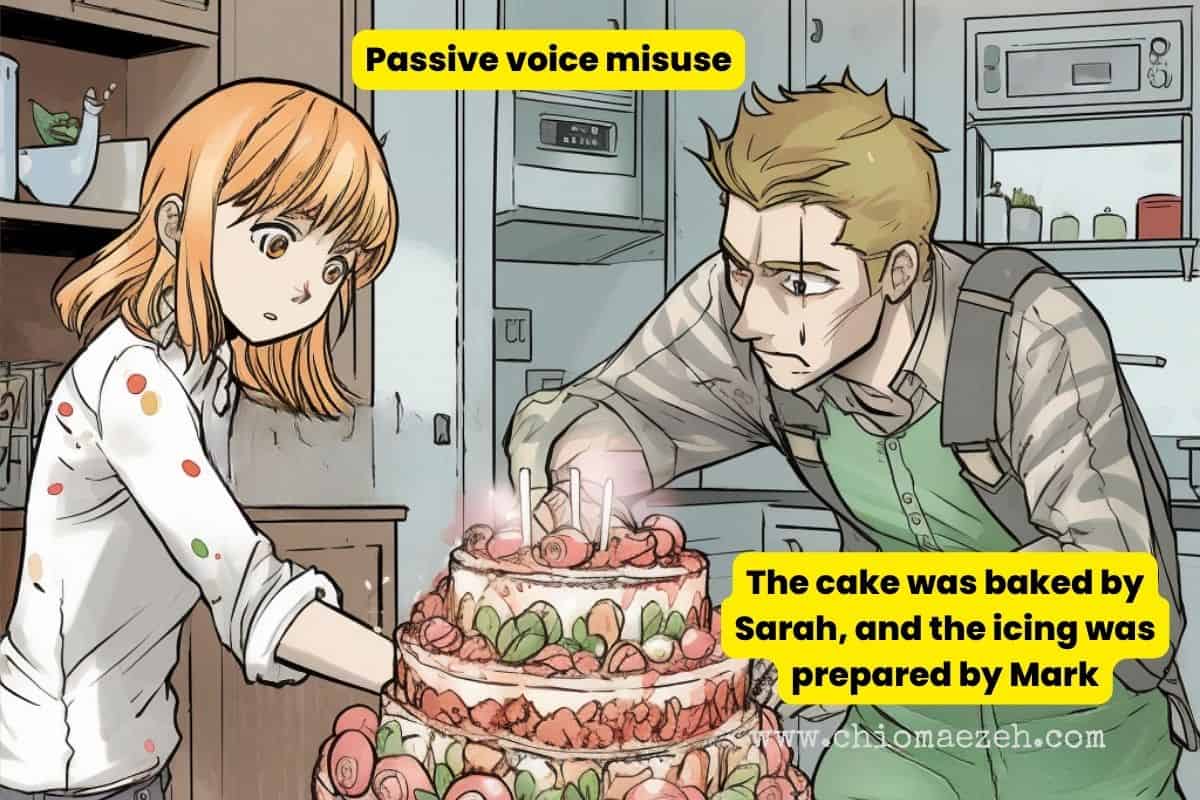Passive Voice Misuse: 4 Simple Ways To Fix For Perfect Writing
Have you ever read a book that was so full of passive voice that it made your head spin?
I once picked up a book and started to read, only to find myself completely lost in an ocean of “was”s and “were”s. It felt like I was being sucked into a vortex of boredom with no hope for escape.
The misuse of passive voice is all too common in books today, making reading tedious and draining any sense of life or excitement out of the story.
As authors, we must be mindful not to fall into this trap if we want our readers to stay engaged with our writing. In this article, we’ll look at how passive voice misuse can ruin even the most interesting stories – and how you can fix and avoid using it in your own work.
👉 See our overview on active vs passive voice in writing.
Let’s Talk
Are you a writer aspiring to pen a masterpiece that never fails to captivate? Look no further. Reach out to us and uncover how we can help you to take your writing to unprecedented heights!

What is Passive Voice?
Passive voice is a sentence structure where the main focus is on the action or the object receiving the action instead of the person or thing doing the action. It uses a “to be” verb followed by a past participle verb. In passive sentences, the focus is on the action or what gets affected, not on who does the action.

For example, compare these two sentences:
Active voice: The dog chased the boy. (The dog is doing the action.)
Passive voice: The boy was chased by the dog. (The cat is affected by the action.)
In the active voice example, the subject, “the dog,” performs the action of chasing. On the other hand, the subject, “the cat,” is the receiver of the action in the passive voice.
Passive voice isn’t wrong or bad; it’s just another way to write sentences, depending on the writing purpose or what the writer wants to emphasize.
👉 See our guide on When to use passive voice in writing.
So, if the passive voice isn’t bad, what then is passive voice misuse?
What Is Passive Voice Misuse?
One reason writers are told to limit the use of passive voice is because it’s very easy to misuse.
Passive voice misuse is an incorrect usage of the passive voice in writing. It is often used when it is not necessary or appropriate, making for confusing and awkward sentences. Passive voice should only be used when the focus of the sentence needs to be on the object or recipient rather than the subject performing the action.
Using passive voice in your writing can be very detrimental to your work as it weakens sentences, makes them difficult to read, and muddles your message. It also takes away from the power of your words since they are not direct enough for readers to easily grasp their meaning.
So, how can you know if you have misused the passive voice?
To determine if you have misused the passive voice in your written work, ask yourself:
Is your sentence written in the passive voice? Would it sound better and make more sense in the active voice? If yes, that’s passive voice misuse.
Let’s look at this example:
“The books were written by them after they received a contract from the publisher”
This is a confusing statement and is also an example of passive voice misuse. Also, it leaves the reader with so many questions. Who wrote the book? Who received the contract?
Passive voice can make sentences unnecessarily complex and can also hide the doer of the action from the reader. Always strive to use the active voice whenever possible to make your writing clearer and more direct.
How Does Passive Voice Misuse Impact Writing?
It is better to use passive voice carefully and choose active voice when it makes writing clearer and simpler. Some common problems with passive voice misuse include:
- Hiding the action’s performer
- Overusing passive voice
- Reducing clarity or readability
- Too wordy
- Boring sentences
- Weak statements
- Cold & impersonal tone
1. Hiding the action’s performer
This is basically not saying who did the action. Using passive voice can sometimes hide who is responsible, making the sentence unclear.
Example: Mistakes were made. (Who made the mistakes?)
2. Overusing passive voice

Passive voice misuse happens when you use passive voice too much. Writing with too much passive voice can be less engaging and more formal. Mixing active and passive voice makes writing more interesting.
Example:
Passive voice: The cake was baked by Sarah, and the icing was prepared by Mark. Once the cake was cooled, it was decorated with the icing by Sarah. Finally, the cake was enjoyed by everyone at the party.
A better version with a mix of active and passive voice:
Active voice: Sarah baked the cake, and Mark prepared the icing. Once the cake cooled, Sarah decorated it with the icing. Everyone at the party enjoyed the cake
3. Reducing clarity or readability
Lower clarity and readability mean sentences become hard to understand. Passive voice can sometimes make sentences more confusing, especially if they are complex.
For example:
Passive voice: The report was reviewed by the manager before it was submitted to the director.
(Clearer with active voice): The manager reviewed the report before submitting it to the director.
It’s important to use passive voice wisely and pick active voice when it leads to clearer and more engaging writing.
Here are a few more common problems with passive voice misuse:
4. Too Wordy Sentences:
Passive voice can make sentences longer and less clear. It often adds extra words to a sentence, making it less concise than its active voice counterpart.
Example: The book was read by John. (Clearer active voice: John read the book.)
5. Boring sentences

Overusing passive voice makes writing repetitive and dull. When you rely too heavily on passive voice, your writing becomes monotonous, as sentences may start to follow a similar pattern.
Example: The car was washed by Sam. The lawn was mowed by Sam. The groceries were bought by Sam.
(Better: Sam washed the car, mowed the lawn, and bought groceries.)
6. Weaker Statements:
Passive voice can make statements weak and less powerful. It dilutes the impact of a statement, which makes it less persuasive or memorable.
Example: The championship was won by our team. (Stronger: Our team won the championship.)
7. Cold and Impersonal tone:
Too much passive voice can make writing feel distant, which may not be good for personal stories or essays. It can make writing sound impersonal or detached; certainly, you don’t want that for certain forms of persuasive writing.
Example: The party was attended by many friends, and a great time was had by all. (Warmer: Many friends attended the party, and we all had a great time.)
How To Identify Passive Voice Misuse
You don’t want to be the victim of passive voice misuse. To identify passive voice misuse, consider the following steps:
1. Recognize passive voice:
Look for sentences where the subject is the receiver of the action, rather than the doer. Passive voice usually includes a form of “to be” (e.g., is, was, were, are) followed by a past participle (e.g., written, taken, broken).
Example: The book was written by the author. (Passive voice)
2. Determine if active voice is clearer:
Check if using active voice would make the sentence clearer or more engaging. If the person or thing performing the action is important, consider using active voice.
Example: The author wrote the book. (Active voice)
3. Examine sentence variety:
Look for patterns of passive voice overuse, which can make writing monotonous. Mix active and passive voice for more engaging writing.
Example: The car was washed. The groceries were bought. The lawn was mowed. (Passive voice overuse)
4. Check for unnecessary wordiness:
Identify sentences that could be made shorter or more concise by using active voice.
Example: The report was submitted by the team. (Passive voice, wordy) The team submitted the report. (Active voice, concise)
5. Assess tone and impact:
Determine if using passive voice weakens the impact of a statement or makes the tone impersonal. If so, consider using active voice to create a stronger, more personal tone.
Example: The trophy was won by our team. (Passive voice, weaker) Our team won the trophy. (Active voice, stronger)
Once you follow these steps, you can easily identify passive voice misuse. Then, you can revise your writing to be clearer, and more concise.
How To Fix Passive Voice Misuse: 4 Ways
If you want to be a good author, you need to stop misusing the passive voice as soon as possible. Luckily for you, there are several ways of doing this.
The following steps will help you fix passive voice misuse in your writing:
- Identify the subject and make object
- Identify the object and make subject
- Cut state-of-being verbs.
- Use Passive Voice Fixer Apps
#1. Identify The Subject And Make Object
Switching between active and passive voice can be a complicated process. But the simplest way of converting between the two is to think of it as changing the position of the subject and the object.
You need to identify the subject before doing anything else. A subject can be defined as an entity that performs a certain action on the verb. Subjects are usually nouns.
Whenever you want to identify a subject, always look for the verb in the sentence. Whoever, or whatever is doing something/performing an action (verb) is the subject.
After finding the subject, move it as close as possible to the beginning of a sentence. Doing this will give you an active voice sentence. Let’s consider the following examples:
Passive Voice Misuse Example
“My manuscript is being edited by Meghan.”
Can you identify the subject in the above sentence? Maybe start by trying to identify the verb first. Luckily for us, the sentence only has one verb/action word. And that is the verb “edited.”
Now, who is doing this editing? “Meghan.” Therefore, Meghan is the subject.
Here is what the same sentence looks like if we move “Meghan” to the beginning of the statement:
“Meghan edited my manuscript.”
The subject doesn’t always have to be the last word in a sentence for passive voice, nor the first word in active voice sentences. But it should be as close to the end and beginning as possible.
#2. Identify The Object And Make Subject
Every sentence is either active or passive voice. Subjects and objects are two important components to identify if you want to convert between the two.
An object is the receiver of action. It is also usually a noun.
Remember how we said verbs are action words? Always identify the verb first. This will help you find the object. The object is the thing that has the action done to it.
Passive voice sentences usually open with the object somewhere near the beginning. An object needs to move closer to the end of a sentence if you want to change it from passive voice.
Passive Voice Misuse Example:
“Thrillers are written by David Baldacci.”
In this case, “written” is the perfect present tense of writing is the action verb. So, what is receiving the action of being written? “Thrillers.” Therefore, thrillers are the object of this sentence.
We can move “thrillers” to the end of the sentence. Our sentence will end up looking like this:
“David Baldacci writes thrillers.”
Don’t let the word “object” confuse you. Object can mean two things in this instance. An object is the recipient of the action, as we just discussed. An object can also refer to everyday objects such as tables, chairs, people, cars, etc. These are also known as nouns. Both subjects and objects are usually nouns.
#3. Cutting state-of-being verbs
State-of-being verbs are also known as linking verbs. Their main goal is to provide information.
State of being verbs communicate a subject and object’s state of being. They usually help us answer the “what” and “why.” They also create a link between a subject and an object and the verb.
Examples of linking verbs include:
- is
- was
- am
- are
- were
Passive Voice Misuse Example:
“The Harry Potter series was written by J.K. Rowling.”
Consider the following:
Object = “Harry Potter series.”
Subject = “J.K. Rowling.”
Verb = “written.”
What connects these three components? This is “was.” “Was” is the state of being verb/linking verb.
We can easily fix it as follows:
“J.K. Rowling wrote the Harry Potter series.”
The first thing we did here was make the sentence shorter and more concise. The original sentence had nine words, while the new sentence has only seven words.
More importantly, we turned the passive voice into an active voice by removing the linking verb.
There’s nothing wrong with linking verbs. In fact, some statements might not make sense when you exclude state-of-being verbs. That said, try to eliminate them from your work where possible.
#4. Use Passive Voice Fixer Apps
There are several passive voice fixer apps on the market that can help writers detect and correct passive-voice sentences.
Although most writing and editing apps can detect passive voice sentences, Microsoft Word’s grammar tool can also do this (though not efficiently). Other popular tools that help you spot passive voice sentences include Grammarly, Hemingway App, and ProWritingAid.
It doesn’t matter how good a tool is. It’s still not as good as a human. This means two things for you.
First, don’t depend on any tool picking up every passive-voice sentence in your passages. Second, just because the tool flags it as passive voice doesn’t mean you have to change anything. Sometimes passive voice works well in certain contexts, so you do not need to change it even if a tool flags it as passive voice.
👉 See our guide on the best passive voice fixer apps
How To Use Grammarly To Fix Passive Voice Misuse
Grammarly is arguably one of the best grammar tools on the market. It also comes with a passive voice checker. Follow these steps to use it:
- Go to https://www.grammarly.com/passive-voice-checker.
- Paste or type your text in the textbox.
- Click View suggestions.
- View the underlined suggestions Grammarly provides.
- Select a suggestion to implement it.
- Copy and paste the corrected text to your document.
While Grammarly has a dedicated passive voice checker, the standard tool on your desktop can also detect passive voice. The steps are the same as those above.
FAQs On Passive Voice Misuse
What is passive voice misuse?
Passive voice misuse occurs when a sentence is written in passive voice when it would be clearer, more concise, or more direct to use active voice. In passive voice, the subject of the sentence is acted upon, rather than performing the action. Misuse can make sentences less engaging, harder to understand, or overly wordy.
Why is passive voice considered problematic?
Passive voice is not inherently problematic, but its misuse can create unclear, wordy, or awkward sentences. Using active voice generally makes writing more engaging, straightforward, and easier to understand by emphasizing the subject performing the action.
When is passive voice appropriate to use?
Passive voice is appropriate when the actor (the person or thing performing the action) is unknown, unimportant, or intentionally being deemphasized. It can also be used when the focus is on the action itself or its recipient rather than the actor.
How can I identify passive voice misuse in my writing?
Look for sentences where the subject is being acted upon instead of performing the action. If rephrasing the sentence in active voice would make it clearer or more concise, consider revising it. Auxiliary verbs like “was,” “were,” “is,” “are,” “will be,” or “has been” followed by a past participle verb often indicate passive voice.
How can I correct passive voice misuse?
To correct passive voice misuse, rewrite the sentence in active voice. This often involves rearranging the sentence so that the subject performs the action. For example, change “The book was read by Jane” to “Jane read the book.”
Is passive voice always incorrect?
Passive voice is not always incorrect. It can be appropriate in certain situations, such as when the actor is unknown, unimportant, or intentionally deemphasized. The key is to use passive voice judiciously and avoid misuse that can result in unclear or overly wordy writing.
Final Notes on Passive Voice Misuse
Passive voice misuse is a nasty habit that makes your work less effective. Follow these steps to fix any problems caused by this manner of writing:
- Identify The Subject and Make Object
- Identify The Object And Make Subject
- Cut state-of-being verbs.
- Change the point of view.
- Use Passive Voice Checker And Corrector Apps.




![How to Develop Your Writing Style As An Author [7 Tips]](https://chiomaezeh.com/wp-content/uploads/2023/03/how-to-develop-your-writing-style-768x512.jpg)

